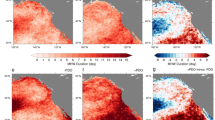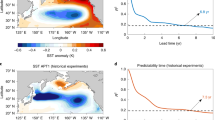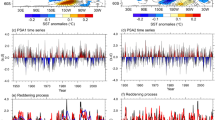Abstract
Between the winters of 2013/14 and 2014/15 during the strong North American drought, the northeast Pacific experienced the largest marine heatwave ever recorded. Here we combine observations with an ensemble of climate model simulations to show that teleconnections between the North Pacific and the weak 2014/2015 El Niño linked the atmospheric forcing patterns of this event. These teleconnection dynamics from the extratropics to the tropics during winter 2013/14, and then back to the extratropics during winter 2014/15, are a key source of multi-year persistence of the North Pacific atmosphere. The corresponding ocean anomalies map onto known patterns of North Pacific decadal variability, specifically the North Pacific Gyre Oscillation (NPGO) in 2014 and the Pacific Decadal Oscillation (PDO) in 2015. A large ensemble of climate model simulations predicts that the winter variance of the NPGO- and PDO-like patterns increases under greenhouse forcing, consistent with other studies suggesting an increase in the atmospheric extremes that lead to drought over North America.
This is a preview of subscription content, access via your institution
Access options
Subscribe to this journal
Receive 12 print issues and online access
$209.00 per year
only $17.42 per issue
Buy this article
- Purchase on Springer Link
- Instant access to full article PDF
Prices may be subject to local taxes which are calculated during checkout






Similar content being viewed by others
References
Bond, N. A., Cronin, M. F., Freeland, H. & Mantua, N. Causes and impacts of the 2014 warm anomaly in the NE Pacific. Geophys. Res. Lett. 42, 3414–3420 (2015).
Baxter, S. & Nigam, S. Key role of the North Pacific oscillation-West Pacific pattern in generating the extreme 2013/14 North American winter. J. Clim. 28, 8109–8117 (2015).
Wang, S. Y., Hipps, L., Gillies, R. R. & Yoon, J. H. Probable causes of the abnormal ridge accompanying the 2013–2014 California drought: ENSO precursor and anthropogenic warming footprint. Geophys. Res. Lett. 41, 3220–3226 (2014).
Wang, S. Y. S., Huang, W. R. & Yoon, J. H. The North American winter ‘dipole’ and extremes activity: a CMIP5 assessment. Atmos. Sci. Lett. 16, 338–345 (2015).
Yoon, J. H. et al. Increasing water cycle extremes in California in relation to ENSO cycle under global warming. Nature Commun. 6, 6 (2015).
Vimont, D. J., Wallace, J. M. & Battisti, D. S. The seasonal footprinting mechanism in the Pacific: implications for ENSO. J. Clim. 16, 2668–2675 (2003).
Anderson, B. T. Tropical Pacific sea-surface temperatures and preceding sea level pressure anomalies in the subtropical North Pacific. J. Geophys. Res. 108, 4732 (2003).
Hobday, A. J. et al. A hierarchical approach to defining marine heatwaves. Prog. Oceanogr. 141, 227–238 (2016).
Whitney, F. A. Anomalous winter winds decrease 2014 transition zone productivity in the NE Pacific. Geophys. Res. Lett. 42, 428–431 (2015).
Peterson, W., Bond, N. & Robert, M. The Blob (Part Three): Going, going, gone? PICES Press 24, 46–48 (2016).
Opar, A. Lost at sea: starving birds in a warming world. Audubon Magazine (2015); https://www.audubon.org/magazine/march-april-2015/lost-sea-starving-birds-warming-world
2015 Large whale Unusual Mortality Event in the Western Gulf of Alaska (NOAA, 2016); http://www.nmfs.noaa.gov/pr/health/mmume/large_whales_2015.html
2013–2016 California Sea Lion Unusual Mortality Event in California (NOAA, 2016); http://www.nmfs.noaa.gov/pr/health/mmume/californiasealions2013.htm
NOAA Fisheries Mobilizes to Gauge Unprecedented West Coast Toxic Algal Bloom (NOAA, 2016); http://www.nwfsc.noaa.gov/news/features/west_coast_algal_bloom/index.cfm
Hartmann, D. L. Pacific sea surface temperature and the winter of 2014. Geophys. Res. Lett. 42, 1894–1902 (2015).
Seager, R. et al. Causes of the 2011–14 California Drought. J. Clim. 28, 6997–7024 (2015).
Anderson, B. T., Gianotti, D. J. S., Furtado, J. C. & Di Lorenzo, E. A decadal precession of atmospheric pressures over the North Pacific. Geophys. Res. Lett. 43, 3921–3927 (2016).
Di Lorenzo, E. et al. North Pacific Gyre Oscillation links ocean climate and ecosystem change. Geophys. Res. Lett. 35, L08607 (2008).
Bond, N. A., Overland, J. E., Spillane, M. & Stabeno, P. Recent shifts in the state of the North Pacific. Geophys. Res. Lett. 30, 2183 (2003).
Mantua, N. J., Hare, S. R., Zhang, Y., Wallace, J. M. & Francis, R. C. A Pacific interdecadal climate oscillation with impacts on salmon production. Bull. Am. Meteorol. Soc. 78, 1069–1079 (1997).
Chhak, K. C., Di Lorenzo, E., Schneider, N. & Cummins, P. F. Forcing of low-frequency ocean variability in the Northeast Pacific. J. Clim. 22, 1255–1276 (2009).
Johnstone, J. A. & Mantua, N. J. Atmospheric controls on northeast Pacific temperature trends and variations, 1900–2012. Proc. Natl Acad. Sci. 111, 14360–14365 (2014).
Di Lorenzo, E. et al. ENSO and meridional modes: a null hypothesis for Pacific climate variability. Geophys. Res. Lett. 42, 9440–9448 (2015).
Alexander, M. A., Vimont, D. J., Chang, P. & Scott, J. D. The Impact of extratropical atmospheric variability on ENSO: testing the seasonal footprinting mechanism using coupled model experiments. J. Clim. 23, 2885–2901 (2010).
Anderson, B. T., Perez, R. C. & Karspeck, A. Triggering of El Niño onset through the trade-wind induced charging of the equatorial Pacific. Geophys. Res. Lett. 40, 1212–1216 (2013).
Xie, S. P. A dynamic ocean–atmosphere model of the tropical Atlantic decadal variability. J. Clim. 12, 64–70 (1999).
Chiang, J. C. H. & Vimont, D. J. Analogous Pacific and Atlantic meridional modes of tropical atmosphere-ocean variability. J. Clim. 17, 4143–4158 (2004).
Vimont, D. J. Transient growth of thermodynamically coupled variations in the tropics under an equatorially symmetric mean. J. Clim. 23, 5771–5789 (2010).
Alexander, M. A. et al. The atmospheric bridge: the influence of ENSO teleconnections on air–sea interaction over the global oceans. J. Clim. 15, 2205–2231 (2002).
Newman, M., Compo, G. P. & Alexander, M. A. ENSO-forced variability of the Pacific Decadal Oscillation. J. Clim. 16, 3853–3857 (2003).
Schneider, N. & Cornuelle, B. D. The forcing of the Pacific Decadal Oscillation. J. Clim. 18, 4355–4373 (2005).
Sydeman, W. J., Santora, J. A., Thompson, S. A., Marinovic, B. & Di Lorenzo, E. Increasing variance in North Pacific climate relates to unprecedented ecosystem variability off California. Glob. Change Biol. 19, 1662–1675 (2013).
Weller, E. et al. Human contribution to the 2014 record high sea surface temperatures over the western tropical and northeast Pacific Ocean [in “Explaining Extremes of 2014 from a Climate Perspective”]. Bull. Am. Meteorol. Soc. 96, S100–S104 (2015).
Smith, T. M., Reynolds, R. W., Peterson, T. C. & Lawrimore, J. Improvements to NOAA’s historical merged land–ocean surface temperature analysis (1880–2006). J. Clim. 21, 2283–2296 (2008).
Kalnay et al. The NCEP/NCAR 40-year reanalysis project. Bull. Am. Meteorol. Soc. 77, 437–470 (1996).
Molteni, F. Atmospheric simulations using a GCM with simplified physical parametrizations. I: model climatology and variability in multi-decadal experiments. Clim. Dynam. 20, 175–191 (2003).
Bracco, A., Kucharski, F., Kallummal, R. & Molteni, F. Internal variability, external forcing and climate trends in multi-decadal AGCM ensembles. Clim. Dynam. 23, 659–678 (2004).
Di Lorenzo, E. et al. Central Pacific El Nino and decadal climate change in the North Pacific Ocean. Nature Geosci. 3, 762–765 (2010).
Kay, J. E. et al. The Community Earth System Model (CESM) large ensemble project: a community resource for studying climate change in the presence of internal climate variability. Bull. Am. Meteorol. Soc. 96, 1333–1349 (2015).
Acknowledgements
We acknowledge the support of the NSF-OCE 1356924, NSF-OCE 1419292 and NSF CCE-LTER. We also thank N. Schneider for feedback and discussion provided.
Author information
Authors and Affiliations
Contributions
E.D.L. and N.M. envisioned and wrote the paper. E.D.L. designed and executed the analyses.
Corresponding author
Ethics declarations
Competing interests
The authors declare no competing financial interests.
Supplementary information
Supplementary Information
Supplementary Information (PDF 1498 kb)
Rights and permissions
About this article
Cite this article
Di Lorenzo, E., Mantua, N. Multi-year persistence of the 2014/15 North Pacific marine heatwave. Nature Clim Change 6, 1042–1047 (2016). https://doi.org/10.1038/nclimate3082
Received:
Accepted:
Published:
Issue Date:
DOI: https://doi.org/10.1038/nclimate3082
This article is cited by
-
Quantifying coastal freshwater extremes during unprecedented rainfall using long timeseries multi-platform salinity observations
Nature Communications (2024)
-
Projected amplification of summer marine heatwaves in a warming Northeast Pacific Ocean
Communications Earth & Environment (2024)
-
Northeast Pacific warm blobs sustained via extratropical atmospheric teleconnections
Nature Communications (2024)
-
Deep learning-based forecasting of sea surface temperature in the interim future: application over the Aegean, Ionian, and Cretan Seas (NE Mediterranean Sea)
Ocean Dynamics (2024)
-
Responses of the Pacific and Atlantic decadal variabilities under global warming by using CMIP6 models
Ocean Dynamics (2024)



